What are the supports for climbing roses and how to make them yourself?

Climbing roses are an unusual decoration for your garden. Such plants are quite often used by landscape designers: climbing roses can be planted in a flower bed, they can be put on a fence or a gazebo, and also turned into an independent hedge.
However, often climbing rose bushes are simply planted in the garden or front garden. In order for such a plant to become an ornament and not spoil the entire appearance of the site, it is necessary to build a support. What types of supports are there and can you make them yourself, read our article.


What are they for?
A support for climbing roses is not a luxury, but a necessity. Only in the presence of such a design, the flower will be able to weave. Moreover, depending on the support, you can adjust the direction of weaving and build decorative compositions from fresh flowers.

Support requirements
Various structures can be used as a support. Whichever type of support you choose, it is important to remember that first of all, this element must fulfill its functional role, and therefore must correspond to some characteristics.
- Reliability and durability. The rose holder must be stable and sturdy. At first glance, it may seem that the climbing rose is a rather light plant in terms of weight, however, in reality this is not entirely true. The blossoming fluffy pink flowers, as well as the developed shoots of the bush can make up a rather large mass, therefore, it is worth ensuring the strength of the support. The rack structure must be well constructed and only quality materials should be used for its construction. In addition, some supports are dug into the soil to provide an additional level of stability.


- Aesthetic appearance. Despite the fact that the stand for a climbing rose, first of all, must perform its functional purpose with high quality, do not forget about the appearance of the structure. So, it is desirable that the support does not stand out in its appearance against the background of the site, it should imperceptibly, but at the same time, fit beautifully into the general landscape. Sometimes, for such purposes, the support is painted in neutral colors or a material of a suitable shade is used.
- Comparability. Sometimes, in pursuit of reliability, gardeners, even on miniature and compact rose bushes, install supports that are rather bulky in size. Such reassurance is unnecessary, and can spoil the appearance of the plant as a whole. Nevertheless, if a rather large bush grows on your site, then you should not choose a support that is too small, not appropriate for the size of the plant.
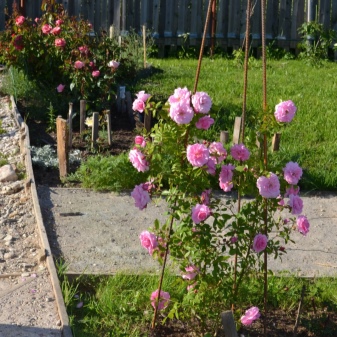
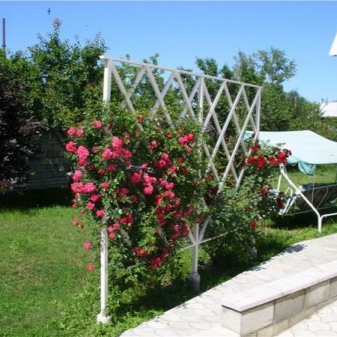
- Environmental Safety. The stand must meet all environmental standards and be safe for nature.
- Convenience and ease of use. As a support for a flower, you should not choose multifunctional, complex and complex structures. The stand must fulfill its main function, and it does not need additional accessories.
- Economy. This function concerns both the material (you should not buy too expensive structure, but you can try to assemble the support yourself) and overall (the rack should not take up too much space) aspects.


Views
Let's take a closer look at the popular and most functional types of stands for a climbing rose.
Trellis
This type is one of the simplest in its design. The tapestry is rarely bought in stores or in the markets, because it is quite easy to make it with your own hands even for a beginner, and this does not require a lot of effort, time, materials or financial resources.
A trellis is a kind of mesh, most often made of wood (usually thin wooden boards are used). It is important to note that such a rose stand meets all the characteristics and features described above.
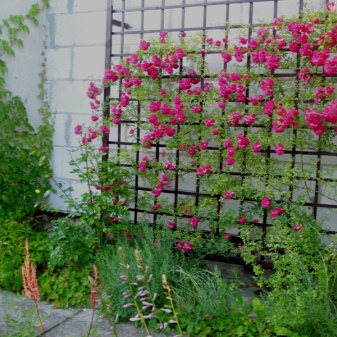

Arch
This type of rack is the second most popular. Structures of this kind combine decorativeness and functionality. In addition, they are able to sustain a fairly large number of roses on their base.
Often, in spacious gardens, a series of arches are built at once, thus constructing a kind of corridor. On each of the arches, both the same and different types of roses can weave. It turns out especially beautifully if you alternate plants of several colors or shades of the same tone.

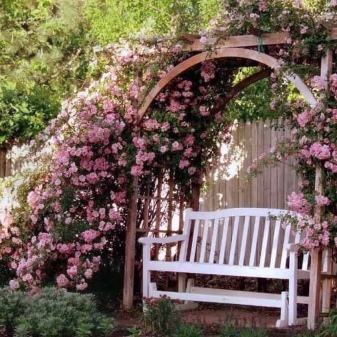
Pergola
A pergola is a slatted roof installed on supporting gardens. This type is an improved analogue of an ordinary arch. Usually, the posts for the arch are made of metal, and the upper part is made of wood.
It should be noted that pergolas and arches, in addition to their direct function of supporting a climbing rose, can also perform an additional purpose, namely: zoning a garden or vegetable garden.
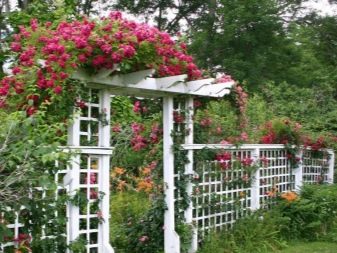

Pillars
This is one of the more obvious options, and yet it may not work for all types of roses. The pillar along which the rose will trail must be made of durable material and also be firmly anchored in the ground. In the garden, you can install single pillars, but you can also design such supports in a row.
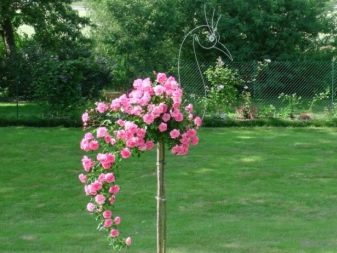

Cones (pyramids)
In order to make a support for a rose in the form of a cone, several pillars should be connected and secured from above. Thus, a rather voluminous stand is obtained - a rose can trail not only outside, but also inside the cone.

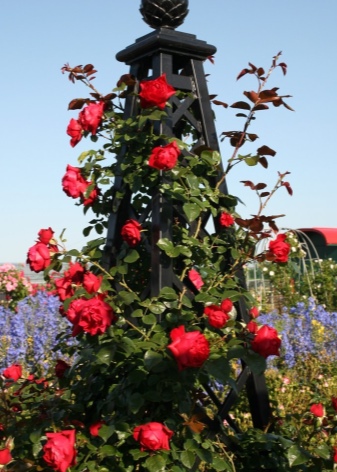
How to choose a material?
The material from which the rose stand is made will largely ensure the reliability of the stand. In general, when choosing one or another raw material for the production of a stand for a plant, you should be guided by the general style of your garden, its appearance. You should also pay attention to the variety of roses, since miniature plants need a stand of less strength, while for large flowers you will need a base that is larger in size. In addition, it is necessary to take into account your material capabilities - you can specially purchase material for the manufacture of a support or use the available tools that you already have on the farm.
A support for a climbing rose bush can be made from the following materials:
- wood (for example, a wooden trellis);
- metal (metal supports for pergolas);
- plastic;
- stone.
Also, these materials can be combined with each other or use any others at your discretion.
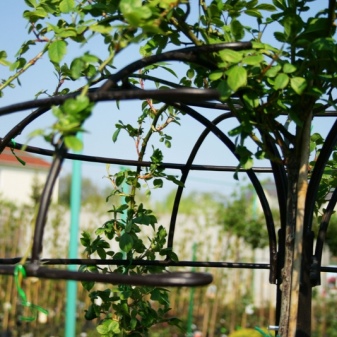

How to create?
If you want to save your family budget and show your creativity, you can make your own rose holders. Tying roses to such a frame will be doubly pleasant. Most often, households make their own arches and trellises. Let's take a closer look at how to design such stands.

Making an arch
For the manufacture of an arch, wood is most often used as a raw material (if you want to make a more "advanced" arch, a pergola, then make the base-pillars of metal, and the top of wood). First of all, it is necessary to make base pillars - for greater stability and reliability, they are dug into the ground, and sometimes they are poured with concrete.It should be borne in mind that the height of the arch should not be less than 2 meters, so take wooden poles with a margin, because some of them will go underground when fastened.
After you have made the pillars, it's time to start designing the top-arch. It is important here to accurately calculate the dimensions. Analyze this parameter in advance, and even before installing the pillars, decide at what distance they will be located from each other.
Having fixed the vault on the pillars, fasten small bars over the entire area of the arch, on which the rose will be attached. For greater aesthetics, you can paint the arch in your favorite color.

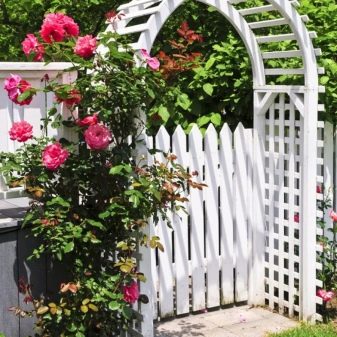
We make a trellis
The height of the trellis, like the height of the arch, must be at least 2 meters. So, first you need to dig 2 pillars into the ground, which will become the basis (watch their height). Next, a lattice should be attached to the posts, along which the rose will curl. There are several options here:
- you can use a grate made of wood pre-made according to the type of a screen;
- an alternative option is to fasten the chain-link mesh;
- another way out is to pull a strong wire or fishing line diagonally.
Whichever of the options you choose, make sure of its strength and reliability before forming a flower arrangement.
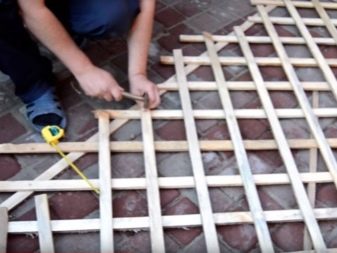

Care and subtleties of the formation of a rose
After you have planted a rose and built a support for it, you need to carefully and with great care distribute the flower on the stand. Be very careful not to damage the flowers or break off the stems, in addition, try to avoid injuries caused by the sharp thorns of the rose (you can distribute the plant on the support with gloves).
When you have already distributed the rose, make sure that the new young shoots are correctly trailed along the structure, do not forget to form a beautiful floral arrangement.
Also, gardeners and landscape designers recommend not neglecting the regular pruning of the plant. Do not forget to also apply fertilizers and fertilizing to the soil (for roses, nitrogen and mineral compounds are optimal additives) - thus, the rose will actively bloom and develop.

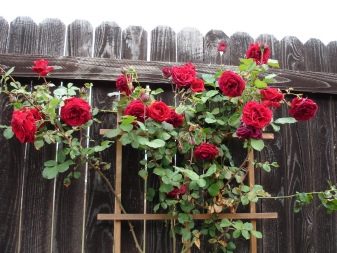
For information on how to make a support for a climbing rose with your own hands, see the next video.

































































































The comment was sent successfully.